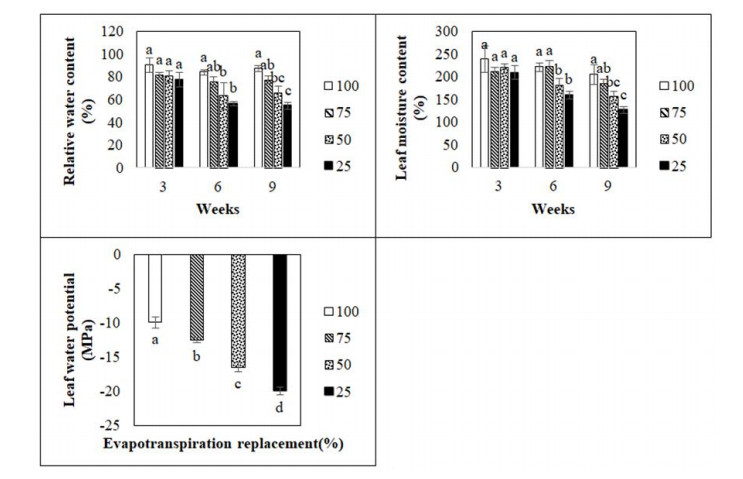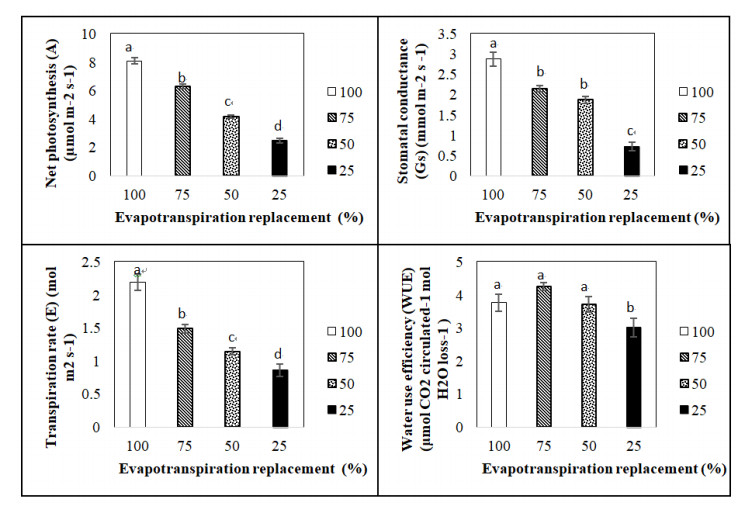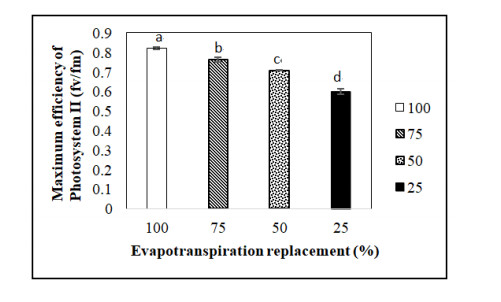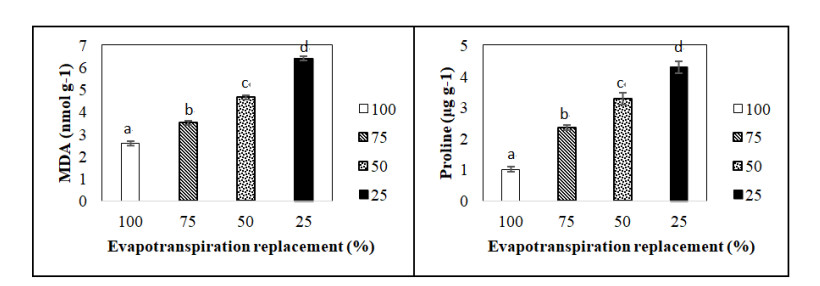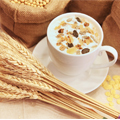Climate change poses significant challenges to the production of oil palm as its output can be directly affected by abiotic stress, especially drought. Thus, this research was designed to investigate the effect of different water stress regimes on the physiology of oil palm seedlings to determine the optimum amount of water that should be applied. Three-month-old Tenera hybrid (Dura X Pisifera) oil palm seedlings were arranged in randomised completely block design (RCBD) and treated with four irrigation regimes: 100% ER (evapotranspiration replacement; well-watered), 75% ER (moderate water stress), 50% ER (high water stress) and 25% ER (severe water stress). Growth, carbon assimilation and biochemical parameters were recorded during the experiment. The results showed severe water stress decreased vegetative plant growth, leaf water potential, relative water content, leaf moisture content, stomatal conductance, transpiration rate, net photosynthesis, water use efficiency and fv/fm (maximum efficiency of photosystem II). The level of malondialdehyde (MDA) and proline increased under water stress. Regarding irrigation, 100% ER (control) was most effective on most parameters, but there was no significant difference to 75% ER. Thus, to optimise the water utilisation, supplying 75% water from soil field capacity on oil palm seedlings is the best option.
1.
Introduction
Oil palm (Elaeis guineensis Jacq.) is a tropical tree native to West Africa and first established in Malaysia as an ornamental crop, but now has becomes one of the major contributors to Malaysia's gross domestic product (GDP) [1]. In 2018, 24.88 million tonnes of oil palm products from Malaysia were exported abroad and the crop covers about 5.85 million hectares of land, making this industry the backbone of the Malaysian's economy [2]. Over the years, Malaysia has become the most significant oil palm producer, and this record will continue.
This plant was expected to be best cultivated in tropical regions, however, due to the phenomenon of global climate change, the production of this crop is expected to decrease up to 30% [3,4,5]. For optimal growth, the oil palm tree needs adequate rainfall, at least 2000 mm/year with no dry season [6,7]. The world's water crisis is becoming one of the foremost issues nowadays due to climate change. Drought is defined as a period of unusually prolonged dry weather, which leads to hydrological balance [8]. Globally, drought is predicted to become more severe and frequent in the future due to anthropogenic activities [9]. Drought is commonly associated with El Niñ o, with El Niñ o playing the most significant role in causing the absence of rainfall for a long period in the tropics [10]. According to Shidiq et al. [11], in Malaysia, the amount of rainfall has decreased from 1979 to 2010. Previously, the occurrences of drought significantly reduced fresh fruit bunches (FFB) and crude palm oil (CPO) by 12% and 10% respectively in Malaysian oil palm production [12,13].
Prolonged drought is reported to reduce the growth and development of oil palm, thus producing less yield [14,15,16], directly impacting the formation of fresh fruit bunch [17]. Water deficiency not only affects mature oil palms but also oil palm seedlings in the nursery stage [18]. Generally, photosynthesis is affected by drought in two ways, stomatal and non-stomatal effect, even though there is long-standing controversy about this matter, whether it is because of the stomata and diffusive resistance or metabolic alterations [19,20,21]. The reduction in photosynthesis has a strong relationship with stomata conductance, which also decreases the transpiration rate and maintains turgor under water scarcity [10,22,23]. Apart from affecting gaseous exchange, other effects of water stress on oil palm seedlings include a reduction in growth and plant water status as well as an impact on biochemical properties [24].
Previously, many modelling studies were conducted to assess the impact of drought on oil palm growth and physiology, but there is lack of studies in the oil palm field [23]. Most previous studies focussed on cyclic water stress where intermittent drought was applied to assess the impact of water stress on oil palm seedlings. There are limited studies using the method of evapotranspiration replacement, where the water is applied based on its soil water capacity. Thus, this experiment was designed to investigate the effect of different water stress regimes using evapotranspiration replacement methods on the physiology of oil palm seedlings to determine the optimum amount of water that should be applied. It is predicted that this research will inform oil palm planters best management practices to reduce water use and minimise crop losses under water limitations in the nursery.
2.
Materials and methods
2.1. Experimental designs and plant materials
The study was conducted in the rain-proofed glasshouse at the Faculty of Science, University Putra Malaysia, Serdang, Selangor, Malaysia from September 2018 to December 2018. Three-month-old oil palm seedlings (DXP) were planted in polybags (10 × 12 cm) with a 16 cm diameter and filled with a topsoil surface layer of Muchong series. Before the experiment started, all seedlings were arranged inside the glasshouse and acclimatised for a month. These seedlings of uniform height and health were laid out in randomised completely block design (RCBD) with three blocks as replications and six plants per experimental unit, totalling 72 seedlings used in the experiment. The water stress treatment started when the seedlings reached four months old and the four irrigation regimes were: 100% ER (evapotranspiration replacement; well-watered), 75% ER (moderate water stress), 50% ER (high water stress) and 25% ER (severe water stress). The ER treatment was applied based on the previous study by Klapwijk and Lint [25]. All seedlings in the polybags primarily received the same volume of water to maintain them to near the predetermined polybag capacity and moisture lost by ER was replaced on alternate days (100%, 75%, 50% and 25%). The water was calibrated once a week and plants were harvested at week 3, week 6 and week 9 after the treatments.
2.2. Vegetative measurements
Measurements of vegetative traits such as bole diameter, the number of fronds, root dry weight, shoot dry weight, total dry weight and leaf area were recorded in the controls and water deficit-treated oil palm seedlings based on MPOB [26]. For bole diameter, the measurement was taken using a digital calliper at the widest point of diameter stem base in two directions at a right angle, while the number of fronds was counted manually in week 3, 6 and 9. Dry weights were obtained by drying the samples using an oven at 75 ℃ for 48 h until the weight was constant. Samples were then weighed using digital balances. The leaf area of oil palm seedlings was measured using a Leaf Area Meter (Li-3100 Area meter, LICOR).
2.3. Plant water status
Relative water content (RWC) was estimated using the method of Weatherly [27]. Three discs samples per palm were taken using a puncher to determine the fresh weight (FW) using a sensitive digital balance (Mettler Toledo AL204). The samples were then kept in water for 24 h to regain full turgor before turgid leaf discs were carefully dried with tissue paper and reweighed (TW). The samples were subsequently oven-dried at 75 ℃ for 24 h and the dry weight (DW) of the sample was recorded. The formula of RWC is as follows:
Leaf moisture content (LMC) was measured when three discs samples per palm were taken using a puncher and the FW was determined using a sensitive digital balance (Mettler Toledo AL204). The samples were then dried in an oven at 75 ℃ for 24 h and the DW of the sample was recorded. The LMC can be deduced from the following equation:
The leaf water potential (LWP) of the E. guineensis leaf samples was determined using a pressure chamber (Model 615, PMS instrument). A fully opened healthy leaf number two was chosen for the measurement at each sampling. As the leaf of oil palm seedlings are big, the leaf was first cut in L shape and placed inside a sealed chamber. Then, the pressure was applied to the leaf and reading was taken when the first water (bubble) appeared at the cut surface. All observations were made in situ between 09:00 and 10:00 h.
2.4. Leaf gas exchanges
The measurement was obtained using a LI-6400XT Portable Photosynthesis System closed infrared gas analyser (Li-COR Inc; Nebraska; USA). The net photosynthesis (A), stomatal conductance (Gs), transpiration rate (E) and water use efficiency (WUE) of oil palm seedlings was recorded between 9.00 am to 11.00 am on fully expanded young leaves number two. The WUE was calculated by dividing the net photosynthesis (A) by corresponding transpiration rate (E). In this experiment on E.guineensis, the instrument was set at 400 μmol mol-1 CO2, cuvette temperature of 30 ℃, air relative humidity of 60% with the air flow rate fixed at 500 cm3 min-1 and modified cuvette at 800 μmolm-2s-1 photosynthetically photon flux density 164(PPFD) [28].
2.5. Maximum efficiency of Photosystem Ⅱ (fv/fm)
The maximum quantum yield of photosystem Ⅱ (fv/fm) was estimated according to Jaafar et al. [29]. The data were recorded around 8.00 am to 10.00 am on fully expanded young leaves number two using a portable chlorophyll fluorescence meter (Handy PEA, Hansatech Instruments Ltd, Kings Lynn, UK). Leaves were darkened for 15 min by attaching dark acclimation clips to the central region of the leaf surface prior to measurements, then fm (maximum fluorescence) and fv (variable fluorescence) were obtained. The ratio of variable to maximum fluorescence (fv/fm) was calculated as the maximum quantum yield of PSII photochemistry.
2.6. Biochemical properties
Lipid peroxidation was determined by estimating the level of malondialdehyde (MDA) in the oil palm seedlings following the method described by Ibrahim et al. [30]. One gram of fresh leaves was ground with a mortar and pestle in 0.5% trichloracetic acid (TCA, 1 mL) and centrifuged at 9, 000 rpm for 20 min. The supernatant (0.5 mL) was mixed with 20% TCA (2.5 mL) containing 0.5% TBA and heated for 30 min at 100 ℃ in a water bath. Then, the supernatant was centrifuged at 9000 rpm for 10 min and the resulting supernatant was used for MDA content determination. The specific absorbance (at 532 nm) of the extract was determined.
The method used for proline determination was that of Bates et al. [31]. The oil palm leaves used for gas exchange and chlorophyll fluorescence measurements were removed and immediately frozen in liquid nitrogen for grinding with a mortar. The homogenate powder was mixed with 1 mL aqueous sulfosalicylic acid (3% w/v) and filtered through filter paper (Whatman #1, England). The, 1 mL of glacial acetic acid and ninhydrin reagent (1.25 mg ninhydrin in 30 mL glacial acetic acid and 20 mL 6 M H3PO4) were added to this solution, incubated for 1 h at 95 ℃ before placed in an ice bath for reaction termination. The solution was mixed vigorously with 2 mL toluene, warmed to 25 ℃ and the chromophore was measured with a B UV-visible spectrophotometer (model DR/4000, HACH, Loveland, Colorado, USA) at 520 nm using L-proline as a standard.
2.7. Statistical analyses
All data were analysed using SPSS statistical software (ver. 25.0 SPSS, Chicago, USA) and were subjected to two-way analysis of variance (ANOVA). Duncan's multiple range test (DMRT) was used to compare the mean. Differences at P < 0.05 were considered significant.
3.
Results and discussions
3.1. Plant vegetative growth
The bole diameter (cm), the number of fronds, root dry weight (g), shoot dry weight (g), total dry weight (g) and leaf area (cm2) for nine weeks were observed as shown in Figure 1. Based on Figure 1, water availability affected many of the measured parameters for oil palm seedlings physiology. As the weeks progressed, the vegetative growth increased with the growing age of oil palm seedlings, with 100% ER (control) giving the highest vegetative growth compared to 75%, 50%, and 25% ER but there was no significant difference between 100% and 75%, while 25% ER significantly decreased the vegetative growth of oil palm seedlings from week six onwards. At the end of the experiment, only seven fronds were produced by 25% ER seedlings compared to 8.3 by 100% ER and 75% ER treatments, there was also a 28.5% reduction of total dry weight in 25% ER compared to control. The bole diameter of 100%, 75% and 50% ER were 25.16 cm, 24.44 cm, and 24.32 cm respectively compared to only 21.33 cm for 25% ER treatments, while the total leaf area for the respective 100%, 75% and 50% ER were 28%, 27% and 19% higher than 25% ER treatment.
In this experiment, water availability had the greatest influence on bole diameter, the number of fronds, root dry weight, shoot dry weight, total dry weight and leaf area of oil palm seedlings. The reduction of plant vegetative growth under water stress could be related to the reduction in cell elongation and expansion due to a reduction in turgor pressure [32], as plant cell growth is most sensitive physiological process due to the water deficit. According to Anjum et al.
[33], drought reduced the growth of sunflowers (Heliantus annuus L.) due to impairment in mitosis as a result of reduced rate of cell division and enlargement. The reduction of plant growth was also due to a reduction in photosynthesis and leaf area development [32]. The decline in photosynthesis lead to limited production of photoassimilates and growth regulators, thus reduced plant growth [35]. As in the current studies, there was a significant reduction in leaf area and the number of fronds of oil palm seedlings under water stress (Figure 1). From the correlations in Table 1, bole diameter had a significant positive correlation with number of fronds (R2 = 0.586; P ≤ 0.01), leaf area (R2 = 0.961; P ≤ 0.01) and net photosynthesis (A) (R2 = 0.595; P ≤ 0.01), indicating that oil palm seedlings reduce their leaf expansion rate and leaf initiation to control transpiration water loss under water stress conditions [36,37,38].
3.2. Plant water status
Figure 2 shows the plant water status of oil palm seedlings as affected by different water treatment levels. Water stress significantly influenced the plant water status of oil palm seedlings (P ≤ 0.05), When the levels of water reduced from 100 > 75 > 50 > 25% ER, the water status, such as RWC, LMC and LWP were found to be lower than the control treatment (100% ER). However, for RWC and LMC, there were no significant differences between the treatment of 100% and 75% ER.
LMC, RWC and LWP are the most widely used approaches for evaluating plant water status, which are significantly affected by the water deficit due to a decrease in the water supply [33,39]. A similar trend has also been reported by Trabelsi et al. [40], where they showed that water stress significantly reduced the plant water status in olive trees (Olea
europaea L. cv. Chemlali). According to Blanch et al. [41], when the RWC percentage reduced more than 30%, irreparable damage occurred to the photosynthetic machinery, which agreed with current studies where the RWC of 50% and 25% ER reduced to 34.17% and 45.18% under high and severe water stress with a significant positive correlation of RWC with fv/fm (R2 = 0.801; P ≤ 0.01) at the end of the experiment respectively, indicating reduced photosystem Ⅱ efficiency under water stress conditions.
3.3. Leaf gas exchanges
Similar to the plant water status, the transpiration rate (E), stomatal conductance (Gs), net photosynthesis (A) and WUE of oil palm seedlings were also influenced by water stress (Figure 3). Water treatment levels show a significant influence on the leaf gas exchange of oil palm seedlings (P ≤ 0.05). At the end of the experiment, both E and A of oil palm reduced about three times and stomatal conductance decreased significantly about fourfold under severe drought stress compared to control. There was no significant difference (P ≤ 0.05) between the mean WUE of 100%, 75% and 50% treatment. Under mild water stress (75%), the oil palm seedlings had a 13% increment compared to control, while the WUE of oil palm seedlings below 75% ER gradually reduced as the water levels decreased. Seedlings treated with 25% ER had the lowest WUE and was significantly different compared to other treatments.
It is well known that drought significantly affects the activity of photosynthesis as water is one of the essential factors for this biochemical process [42]. The reduction of leaf gas exchange under water stress has been observed in many other crops such as strawberry, walnut and olive trees [43,44,45]. As observed in this study, there was a strong relationship between A, Gs and E. Stomatal closure is one of the first responses as plants are exposed to water stress [33]. Stomata conductance (Gs) indicates the degree of stomatal opening, measuring the rate of CO2 entering and water vapour exiting through the stomata [46]. The reduction of Gs under water stress in oil palm seedlings is due to the production of abscisic acid (ABA), which pumps out the potassium to close the stomata to minimise transpiration loss [33,47]. However, this stomata closure also inhibits the diffusion of CO2 into the leaf, thus reducing net photosynthesis (A) [35,48]. From the correlations in Table 1, Gs (R2 = 0.922; P ≤ 0.01) and E (R2 = 0.885; P ≤ 0.01) had a significant positive correlation with A, indicating the low Gs and E might trigger the reduction of A under water stress conditions.
Water use efficiency indicates plant adaptability to water stress and WUE will increase under a certain degree of soil water deficiency [45]. The enhancement of WUE under 75% E might be due to the high net photosynthesis rate at low transpiration [44] but under 25% ER, it reduced the WUE severely. According to Puangbut et al. [49], the effect of water stress on the WUE is dependent on the severity and duration of drought. The effect of WUE in plants under water stress was also discussed by Suresh et al. [23] in oil palm seedlings, where the WUE of this crop increased under water stress until 16th day, declining sharply after. As shown in this experiment, WUE had a significant positive correlation with Gs (R2 = 0.492; P ≤ 0.05), which is due to reduced stomatal conductance causing a more significant decline in transpiration rate than photosynthetic rate.
3.4. Maximum efficiency of Photosystem Ⅱ (fv/fm)
The maximum efficiency of photosystem Ⅱ (fv/fm) of different water treatments to oil palm seedlings is shown in Figure 4. The fv/fm was found to be statistically significant in 100%, 75%, 50% and 25% ER (P ≤ 0.05). As the levels of water reduced from 100 > 75 > 50 > 25% ER, the fv/fm was lower than 100% ER (0.82) and 25% ER showed the lowest fv/fm compared to others (0.6). Fv/fm indicates the capacity of PSII to transfer an electron in the stomata where it has a high correlation to the quantum efficiency of net photosynthesis (A) [50]. Few studies relate the water stress with the impairment in photosynthetic apparatus in PSII as drought reduced electron transport through these two systems [42]. Correlation analysis showed that fv/fm had a significant positive relationship with RWC (R2 = 0.801; P ≤ 0.01) and LMC (R2 = 0.619; P ≤ 0.01) (Table 1), suggesting a reduction of PSII activity with decreased water plant status. These results are consistent with those reported by Ju et al.
[51] in their study on the grapevine and according to Naidoo and Naidoo [52], the value of fv/fm should be between 0.81–0.82 for photosystem to be functioning efficiently. Water stress leads to the deterioration of thylakoid membranes [42] and it is reported that drought resulted in damage to the oxygen-evolving complex and to the PSII reaction centres [53,54].
3.5. Malondialdehyde (MDA) and proline levels
As both plant vegetative growth and leaf gas exchange decrease with the reduction in water levels, MDA and proline levels showed an increasing trend. There was a significant difference (P ≤ 0.05) between the mean MDA and proline of each treatment. The MDA of oil palm seedlings gradually increased as the water levels decreased, with 25% ER having the highest MDA level of 3.81 nmol g-1, followed by 2.06 nmol g-1 in 50% ER and 0.92% nmol g-1 in 75% ER from the control respectively. It was found that water stress also significantly affects proline production in oil palm seedlings (P ≤ 0.05), with the proline content of oil palm seedlings gradually increasing as the water levels decrease. At the end of the experiment, the proline level under severe water stress (25% ER) rose fourfold compared to control (100% ER).
MDA is the rate of lipid peroxidation, which is commonly used as a biochemical indicator to evaluate oxidative damage in plants under drought stress [55]. A significant negative relationship was established between MDA levels and RWC (R2 = -0.771; P ≤ 0.01), indicating the level of biochemical properties of oil palm seedlings reduced as plant water status reduced (Table 1). Other plants species that produce a significantly high level of MDA under drought stress include sunflower [56] and shrubs species [57]. Commonly, plants under stress will produce more ROS, which cause severe damage to the photosynthetic apparatus [47]. Thus, a high concentration of MDA under water stress is to prevent the formation of ROS [58,59].
Apart from MDA, proline is also one of the stress indicators of a water deficit. Proline is among the most crucial cell solute important in antioxidant systems, stabilisation of enzymes, signal transduction and detoxification of ROS [22,57]. A study of proline levels in drought stress was also conducted in the oil palm nursery, where it increased when water was reduced and decreased during re-watering [22]. Abdul Jaleel et al. [32] state that high proline production helps plants to maintain low water potential and derive water from the environment under stressful conditions.
4.
Conclusions
The current study demonstrated that ER treatments had significant effects on plant physiology of oil palm seedlings, with severe water stress (25% ER) causing a decrease in oil palm seedlings vegetative growth, plant water status, stomatal conductance, transpiration rate, net photosynthesis, water use efficiency and fv/fm, but increase in MDA and proline. The 100% ER had the most favourable effects on the parameters measured but were not significantly different from 75% ER, thus the best option to optimise water utilisation is the application of 75% water from the soil field capacity on oil palm seedlings.
Acknowledgements
The authors wish to thank the Ministry of Higher Education Malaysia for their financial support through FRGS Grant no. FRGS/1/2016/STG03/UPM/02/6/5524945.
Conflict of interest
The authors declare no conflict of interest in this paper.










 DownLoad:
DownLoad:
